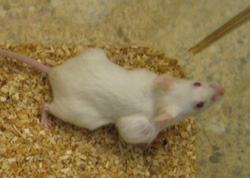UC San Diego Biologists Find Way to Lower Tumor Risk in Stem Cell Therapies
JULY 8, 2010
By Kim McDonald

Mice with dysfunctional immune systems that receive human embryonic stem cells produce tumors called teratomas.
Credit: Xu lab, UCSD
One of the characteristics of embryonic stem cells is their ability to form unusual tumors called teratomas. These tumors, which contain a mixture of cells from a variety of tissues and organs of the body, are typically benign. But they present a major obstacle to the development of human embryonic stem cell therapies that seek to treat a variety of human ailments such as Parkinson's, diabetes, genetic blood disorders and spinal cord injuries.
Now a team of biologists at UC San Diego funded by a grant from the California Institute for Regenerative Medicine, the state's stem-cell funding agency, has discovered a way to limit the formation of teratomas.
In this week's issue of the Proceedings of the National Academy of Sciences, the researchers report that they have identified a new signaling pathway critical for unlimited self propagation of embryonic stem cells. Using small molecule compounds that inhibit this pathway, the scientists were able to dramatically reduce the potential of embryonic stem cells to form teratomas.
"Human stem cell therapy involves differentiating human embryonic stem cells into the kinds of cells needed for the treatment," said Yang Xu, a professor of biology who headed the team that published the report. "But this differentiation is never complete, meaning that the final product is a mixture of cells inevitably containing undifferentiated embryonic stem cells. So by transplanting these cells into a patient, there's clearly a risk of producing teratomas."
If researchers could halt the propagation of human embryonic stem cells during lineage-specific differentiation before they are transplanted, they could avoid the risk of producing teratomas.
"This is a proof of concept to show how we can avoid teratomas in human embryonic stem cell therapies by studying the basic biology of these cells," said Xu. "At this point, we only see a significant but partial effect because we are targeting only one pathway. Once we identify more pathways required for teratoma formation by embryonic stem cells, we might be able to completely suppress the formation of teratomas by targeting multiple pathways simultaneously."
Other scientists involved in the discovery were Steven Briggs, a professor of biology at UCSD, and UCSD biologists Matteo Moretto-Zita, Hua Jin, Zhouxin Shen and Tongbiao Zhao.
Xu recently received a $1.2 million grant from the California Institute for Regenerative Medicine for another research effort to explore a new strategy to induce immune tolerance to grafted cells derived from human embryonic stem cells.
Media Contacts:- Kim McDonald (858) 534-7572, kmcdonald@ucsd.edu
- Yang Xu, (858) 822-1084, yangxu@ucsd.edu
